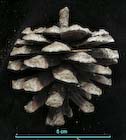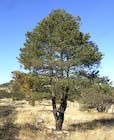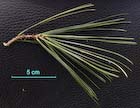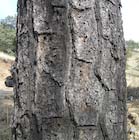
Drawing by Matt Strieby [2016].

Large tree near 23.95°N, 104.85°W [C.J. Earle, 2007.02.10].

Cone collected at km 259 on Mex-16 E from Hermosillo [C.J. Earle, 2007.02.07].

Sapling 6 m tall at 23.9345°N,104.8968°W [C.J. Earle, 2007.02.10].

Foliage and twig on a tree at 28.3852°N, 108.8834° W [C.J. Earle, 2007.02.07].

Cones and foliar units on a tree at Massai Point, Arizona [C.J. Earle, 1989.01.07].

A tree about 40 cm dbh, at 28.3852°N, 108.8834°W [C.J. Earle, 2007.02.07].

Pinus leiophylla subsp. chihuahuana
(Engelm.) A.E.Murray (1982)
Common names
Ocote blanco, ocote chino, pino real [Spanish]; Chihuahua pine (Elmore and Janish 1976).
Taxonomic notes
Syn: Pinus chihuahuana Engelmann 1848; P. leiophylla var. chihuahuana (Engelm.) Shaw 1909.
Description
Tree 10-15(-25) m tall and 20-60(-90) cm dbh, slender, with a single round trunk, often forked higher up; crown conic, becoming rounded. Bark brown to red-brown, narrowly furrowed, cross-checked into long, irregularly and narrowly rectangular, flat, scaly ridges. Branches ascending; twigs slender, orange-brown or glaucous and violet, aging red-brown, ±smooth or cracking. Buds ovoid, light red-brown, ca. 0.6-0.7(1) cm, slightly resinous. Leaves (2-)3(-4) per fascicle, spreading-ascending, persisting 2 years, (4-)6-12(-15) cm × 0.8-1.3(-1.5) mm, straight to slightly twisted, dull gray-green, with 5-8 lines of stomata on the convex abaxial face and 3-4 lines on each adaxial face, margins finely serrulate, apex acute to acuminate; sheath to 1.5 cm, shed early and completely. Resin canals 4-6, medial, sometimes 1-2 internal. Pollen cones broadly ellipsoid, ca. 10-15 mm, brown or yellow. Seed cones maturing in 3 years, shedding seeds soon thereafter but long-persistent, paired or solitary, symmetric, lateral, narrowly ovoid before opening, broadly ovoid to nearly globose when open, 3.5-5(9) cm, chestnut brown or greenish brown, aging gray to gray-brown, stalks to 1.5 cm; apophyses slightly thickened and raised, not keeled; umbo central, slightly raised or depressed, with short, often deciduous prickle or unarmed. Seeds obovoid; body ca. 2 mm, gray, mottled darker; wing ca. 10 mm, dark-lined. 2n=24 (Kral 1993, Farjon and Styles 1997).
It differs from subsp. leiophylla "in its dark, less roughened bark, its shorter range of leaf length, and its slightly broader leaves that occur more consistently in threes" (Kral 1993). In my observations of this tree in Chihuahua, it seemed that young trees (saplings) had predominantly 2-needled fascicles.
Distribution and Ecology
USA: E central & SE Arizona, and SW New Mexico; Mexico: NE Sonora, W Chihuahua, Durango, Nayarit, N Jalisco, and Zacatecas, along the Sierra Madre Occidental at 1500-2700(-2950) m elevation. Where sympatric with subsp. leiophylla, it usually grows to lower elevations, where it may occur with other xerophytes including Pinus cembroides, Juniperus spp., Opuntia spp. and Arctostaphylos spp. At higher elevations, its habitat is usually on rocky ridges and mountain slopes with P. engelmannii and P. arizonica, and farther south, with a broad suite of Pinus and Quercus species (Farjon and Styles 1997).
Remarkable Specimens
As of 1998, the largest specimen in the United States was 26.5 m tall and 98 cm dbh, with a crown spread of 10.4 m, at Fort Apache Indian Reservation in Arizona (American Forests 2005). I have no data on big trees in Mexico.
Ethnobotany
Observations
In the U.S., it is easy to find at Cochise Head and Chiricahua National Monument, both in the Chiricahua Mountains of southeast Arizona. In Mexico, it is very common along Mex-16 from a bit W of the Sonora-Chihuahua border eastward to the foot of the mountains. It can be found pretty widely in the eastern montane elevations of the Sierra Madre Occidental. Along Mex-40 W from Durango, it appears along with P. cembroides and P. pseudostrobus about 30 km W of town, and continues common along the highway until P. durangensis starts to appear; in this area trees intermediate between subsp. leiophylla and subsp. chihuahuana can be found. By the way, continuing along Mex-40, with a day spent to wander side roads out of the town of El Salto, will provide one of the most rewarding conifer-hunting excursions to be found anywhere in Mexico. In a hurried two days, I ran across a Hesperocyparis, three Juniperus, two Abies, and at least 13 taxa of Pinus, and I know that with a little more preparation I could have added at least one Picea, two more Juniperus, and two or three more Pinus taxa. There are not many places where you can easily see 25 conifer taxa, native in habitat.
Remarks
This species is a principal host for the dwarf mistletoes Arceuthobium gillii, A. nigrum, and A. yecorense (Hawksworth and Wiens 1996).
Citations
American Forests 2005. The National Register of Big Trees 2005. Washington, DC: American Forests.
Murray, A. Edward. 1982. Kalmia 12:23.
See also
FEIS database (considerable detail on ecology; large bibliography).
Peattie (1950).
Perry (1991).







